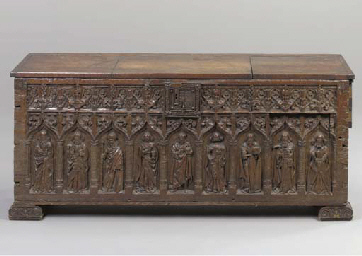The Gothic Style - the dominant aesthetic of the Middle Ages was perceived as the antithesis of the civilized Classical world. It was a Norman innovation, fusing Carolingian and Burgundian artistic traditions with Islamic elements from Saracen Sicily.
The greatest achievements of Gothic art were the cathedrals of northern Europe, the elements from the ecclesiastic architecture formed the basis of Gothic furniture design.
The Gothic style was based on the replacement of the rounded Romanesque arch with the innovative pointed arch, a feat of engineering that meant churches could be larger - because the weight of the church's roof could be supported on a framework of open-work piers and ribs, instead of massively thick walls.
The architectural structure was reflected in the elaborate tracery of cathedral and church windows, and the trefoil and quatrefoil motifs used lent themselves equally well to the decoration of benches and tables.
The upright press developed as a place to store priest's robes - and began to replace the chest as the preferred receptacle for clothing.
Another innovation of the Gothic period was a type of fitted furniture, the cupboard, its name derived from its original function, which was to display valuable silver-plate (cups) in wealthy households. Regional variations in the style included a predilection for linenfold panelling among English and Flemish craftsmen.
With the exception of Italy, where the prevailing fashion remained Romanesque, the Gothic style dominated Europe until the 15th century, and lingered even after the renaissance sought to reject it in favour of a return to the Classical tradition.

Medieval Interiors
Contrary to the common perception of Gothic style as dark and stuffy, the interiors and furniture, now antique furniture, of the period were remarkably light and colourful.
Furniture makers usually had to make do with native woods, in England and northern Europe - Oak, Pine and Fir in the Alps and Fruitwoods in the Mediterranean. Surviving medieval furniture made from Oak invariably looks very dark because of its acquired patina, but newly cut Oak is much lighter. In addition, many items of handmade furniture were painted in bold hues, including primary colours and gold tones.
Chests in particular were often painted - although relatively few examples survive today, it is still possible to see traces of medieval painting on the ceilings and walls of many churches and cathedrals, which were originally decorated in the same way.
No comments:
Post a Comment